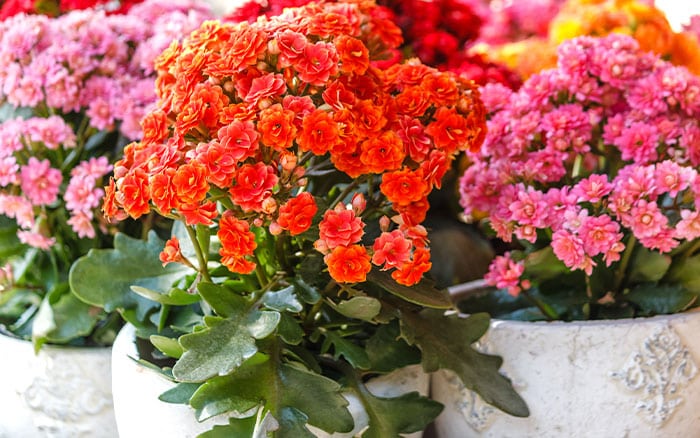Kalanchoes are beautiful houseplants to grow, and they’re pretty easy to care for too. The most commonly known is Kalanchoe blossfeldiana or flaming Katy which has wonderfully bright flowers that can be found in yellow, red, orange, white and pink.
They are an extremely popular houseplant, and commonly given as gifts through the year. So, if you have been gifted one or are adding one to your houseplant collection, here’s how to best care for it…
Flaming flowers
They will be in flower when you buy them, and their flowers can last for around 8 weeks. When they’ve finished flowering, many people may discard the plant – but they can flower again, so don’t give up.
Kalanchoes are succulents, with fleshy deep-green leaves that have slightly scalloped edges. This means it’s best to take care to not overwater, instead water when the compost is beginning to dry out. Through spring and summer, feed with an all-purpose houseplant fertiliser weekly or fortnightly, to encourage growth.
When positioning them, keep them out of reach from children and pets as they can be harmful if eaten.

Place the flaming Katy in a on a sunny windowsill out of direct sunlight. Their name Kalanchoe blossfeldiana comes from Robert Blossfeld who discovered the plant in Madagascar, and although they are native to warm climates, they will happily grow in average room temperature in the UK.
Keep up care

This houseplant is a fast-grower and can become leggy if you don’t keep it in check. Therefore, it’s ideal to prune the plant after flowering to keep the growth compact and dense.
When repotting, place into a container that is one size up using peat-free houseplant or cactus compost.
Using cactus compost ensures that water can drain away effectively because too much water will lead to root rot. It’s ideal to add some grit or stones to the bottom of the container to encourage drainage too.
Re-flower power
It may take a little effort to get a flaming Katy to reflower, but it’s worth it for the colourful cloud of flowers that follow. To flower again, the plant needs a period of time that has short days and long nights, which means you need to mimic these conditions by giving them 8-9 hours of daylight for a month.
The rest of the time, place them in a dark cupboard so they can produce buds. Water occasionally, and within 2-3 months you should see new buds. When this happens, you can resume normal care in terms of watering and feeding.

Take your pick

Though Kalanchoe blossfeldiana may be the most common as a houseplant, there are many types of Kalanchoe to try. For example, Kalanchoe thyrisflora (paddle plant) is grown for its foliage rather than flowers. It has fleshy grey leaves that are margined with red colouring, for a bit of depth to your houseplant display.
Kalanchoe daigremontiana (Mexican hat plant) has large fleshly leaves that have many baby plants on each lead edge.
These mean it’s easy to grow on and increase stock to share with loved ones. This Kalanchoe is happy on sunny windowsill, watering when the top of the soil begins to dry out, feeding monthly in summer.

Leave A Comment